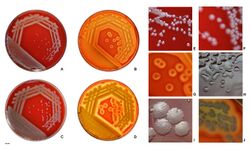| Display title | Biology:Colonial morphology |
| Default sort key | Colonial morphology |
| Page length (in bytes) | 13,563 |
| Namespace ID | 3026 |
| Namespace | Biology |
| Page ID | 321358 |
| Page content language | en - English |
| Page content model | wikitext |
| Indexing by robots | Allowed |
| Number of redirects to this page | 0 |
| Counted as a content page | Yes |
| Page image |  |
| HandWiki item ID | None |
| Edit | Allow all users (infinite) |
| Move | Allow all users (infinite) |
| Page creator | imported>Rtextdoc |
| Date of page creation | 22:41, 8 August 2022 |
| Latest editor | imported>Rtextdoc |
| Date of latest edit | 22:41, 8 August 2022 |
| Total number of edits | 1 |
| Recent number of edits (within past 90 days) | 0 |
| Recent number of distinct authors | 0 |
Description | Content |
Article description: (description)
This attribute controls the content of the description and og:description elements. | In microbiology, colonial morphology refers to the visual appearance of bacterial or fungal colonies on an agar plate. Examining colonial morphology is the first step in the identification of an unknown microbe. The systematic assessment of the colonies' appearance, focusing on aspects like size, shape... |

